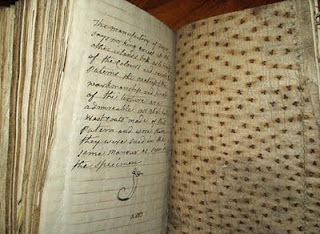Clements Library conservator Julie Fremuth has worked at the Library for 21 years. One of her favorite items from the collection is this book of Polynesian tapa cloth samples, gathered during the voyages of the 18th century English explorer Captain James Cook. As an artist, Julie finds inspiration in the vivid colors, patterns, and textures of the cloth, still beautifully preserved in this volume after more than two hundred years.
The Library acquired the book in 1958. As reported in the June 1958 issue of The Quarto (no. 41), “This volume we had always lacked, until we found an extraordinary example which we felt we must obtain to complete our collection on Cook … This is the largest of the sample books known and probably unique.”
The book is described in greater detail in One Hundred and One Treasures from the Collections of the William L. Clements Library, including the history of this particular copy:
“When Captain Cook’s Discovery returned from the third voyage of 1780 — Cook having been killed two years earlier by natives at Kealakekua Bay, Hawaii, and buried in a sea coffin — the ship carried with it plants, specimens, and artifacts of great fascination. Among them were many rolls of tapa cloth which the Polynesian women made from the bark of the paper mulberry tree. Alexander Shaw, a London merchant, was able to obtain specimens of the textured cloth with its striking patterns and designs and put together A Catalogue of the Different Speciments of Cloth Collected in the Three Voyages of Captain Cook, to the Southern Hemisphere; with a Particular Account of the Manner of Manufacturing the Same in the Various Islands of the South Seas. He printed his list as a pamphlet in 1787, bound it with a selection of 45 to 60 swatches of the cloth, two or four to a page, and distributed copies to friends. The book is a great rarity, and the Clements Library copy is uniquely special.
Thomas Pennant (1726-1798) was one of the most admired naturalists of the eighteenth century, and when he saw a copy of the book, he called on Shaw and obtained every existing sample, both from Shaw and apparently other sources, cut them to full page size, and bound them with Shaw’s essay. To supplement the printed identification, he sought out and interviewed several of Cook’s sailors, writing on blank interleaves where, when, and by whom each sample was acquired, and how the different types of cloth were used by the natives. The result was a fat book containing 92 samples and a unique body of ethnological information.” (101 Treasures, p. 99-100)
The Clements Library collections include a number of other books and maps related to Captain Cook’s explorations, including the first printed account of Cook’s first voyage, A journal of a voyage round the world, in His Majesty’s ship Endeavour (published anonymously in 1771), and the official published accounts of all three voyages:
- John Hawkesworth, An account of the voyages undertaken by the order of His present Majesty for making discoveries in the Southern hemisphere (London, 1773). 3 vols.
- James Cook, A voyage towards the South pole, and round the world (London, 1777) 2 vols.
- James Cook, A voyage to the Pacific ocean (London, 1784). 3 vols. and atlas.


